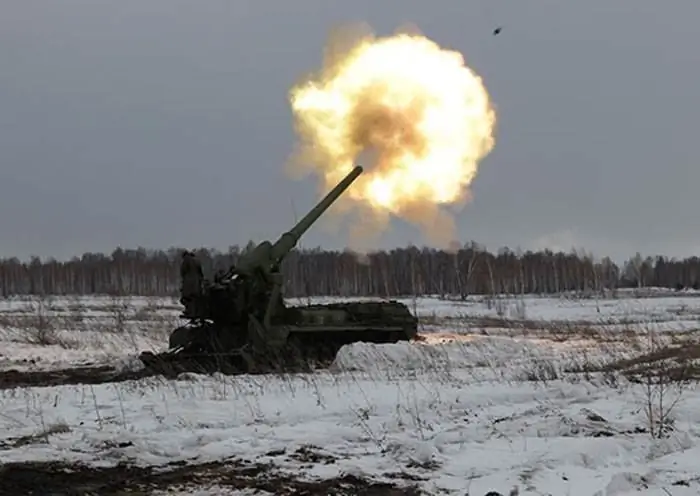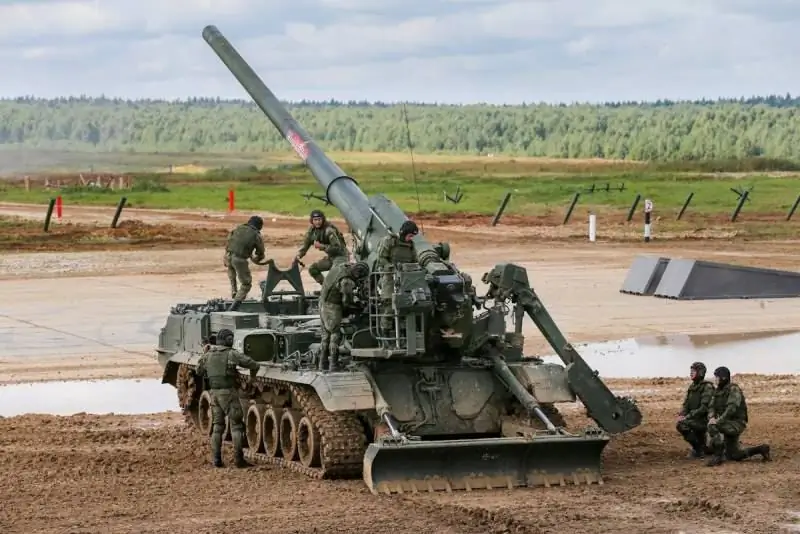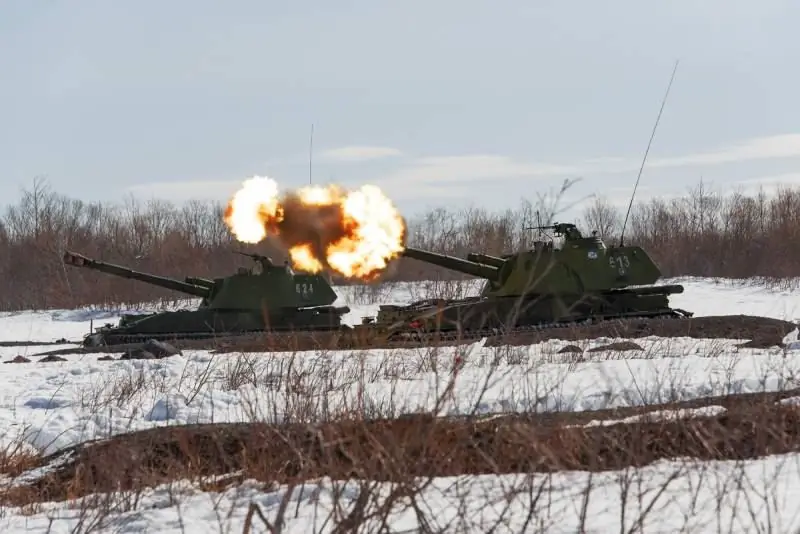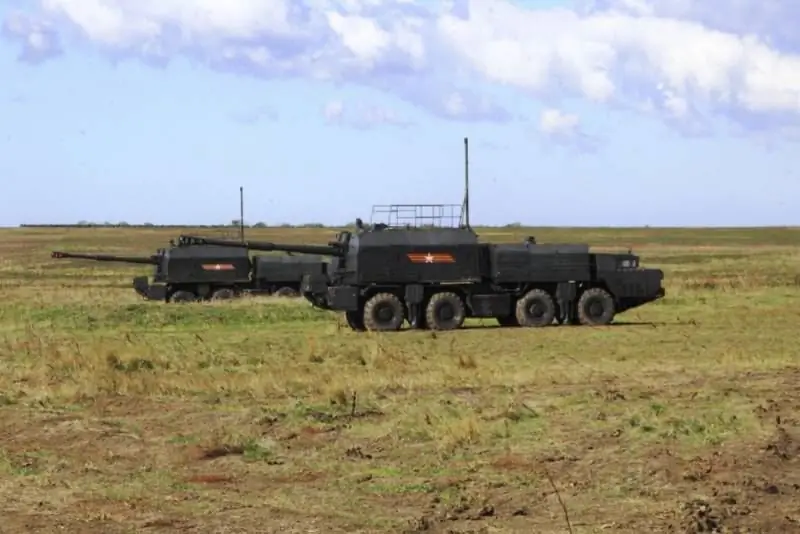- Author Matthew Elmers [email protected].
- Public 2023-12-16 21:49.
- Last modified 2025-01-24 09:17.
The artillery of the coastal forces of the navy will receive new weapons systems. In addition to the existing towed and self-propelled systems, they will receive 2S7 Pion products. In the coming months, self-propelled guns of 203 mm caliber will be delivered to units of the Baltic Fleet. Then the delivery of such equipment to troops in other directions is expected. The positive consequences of such rearmament are obvious.

Latest news
On September 16, Izvestia reported about the transfer of the Peonies to the coastal troops. In the future, the artillerymen of the coastal troops of all fleets will receive new weapons, and the Baltic will be the first. In addition to the 2S7 cannons, the artillerymen will receive Zoo counter-battery firing radars. The new materiel will increase the combat potential of the coastal forces as a whole.
The main formations and units of the coastal forces of the Baltic Fleet are part of the 11th Army Corps. In Kaliningrad, the 244th Artillery Neman Red Banner brigade of the orders of Suvorov and Kutuzov, armed with various guns, is serving. Apparently, it is she who will have to master the new technique.
According to Izvestia, self-propelled guns will be delivered to the Baltic Fleet at the end of this year or early next. More exact dates, as well as the number of transmitted "Peonies" have not yet been published.
It should be noted that previously there were no 2S7s from the coastal forces. The Russian Navy is armed with various artillery systems, but the "Peonies" were previously available only to the ground forces. Now both the army and the navy will have them, which can give certain advantages.
Cannons and locators
At the moment, the self-propelled gun 2S7 "Pion" is one of the most powerful domestic artillery systems capable of showing unique combat qualities. The solution of the main tasks is entrusted to such equipment, and in the near future such an effective tool will be available not only to the ground forces.

Fighting vehicle 2S7 "Pion" or 2S7M "Malka" carries a rifled cannon 2A44 caliber 203 mm with a barrel length of 55 calibers. The gun mount is mounted on a self-propelled armored tracked chassis with high mobility. In recent years, a project for the modernization of equipment has been implemented, which provides for the replacement of part of the equipment and the introduction of new fire control equipment. All these improvements provide the updated technique with significant advantages over the basic model.
The 2S7 ammunition can include seven types of shots for different purposes. Nuclear weapons have also been developed in the past. Conventional shells have a mass of about 110 kg and carry a warhead weighing 13-17 kg. The maximum firing range depends on the type of projectile. The largest is shown by the active-reactive 3OF44 - 47, 5 km. The "Pion" independently transports 4 shots, the "Malka" - 8. As a result, the bulk of the 40-round ammunition load is transported by a separate transport vehicle.
The 1L259 Zoo reconnaissance radar complex is designed to track the flight of artillery shells. It is intended for reconnaissance of enemy positions and for monitoring the results of firing of its own artillery. Also, the radar of the complex is capable of tracking aircraft and issuing data about them. The equipment of the complex is mounted on an armored chassis MT-LBu, which simplifies deployment and departure from position.
When working on large-caliber artillery shells, the Zoo complex is capable of calculating the positions of guns at ranges of up to 15-20 km. For multiple launch rocket systems, this parameter increases to 25-35 km. Data about the enemy or about the places where their shells fall are automatically issued to the command post.

"Peonies" and "Zoos" can be used to effectively defeat various targets that the coastal forces are facing. First of all, these are enemy troops in positions, fortified objects, warehouses, etc. It is also possible to use artillery against surface targets. The presence of radar reconnaissance provides both timely target detection and fire adjustment.
203-mm shells of all types are highly powerful and capable of effectively hitting a wide range of targets. Depending on the type of target, the Pion crew can use high-explosive, concrete-piercing or cluster shells.
With the help of modern communication systems, "Pions" will be included in the general control loops, ensuring effective joint work with other artillery complexes and branches of the armed forces. Having received self-propelled guns 2S7, artillery units already in service with various self-propelled guns and towed guns, will become a more flexible tool for solving combat missions.
Other implements
The coastal forces of the Navy are armed with several artillery systems of different classes, both towed and self-propelled - from portable 82-mm mortars to 152-mm self-propelled howitzers. Almost all such samples are used not only by coastal forces, but also by ground forces.
The most powerful and long-range models of cannon artillery in the coastal forces are still the 2S19 "Msta-S" self-propelled gun, as well as the towed systems 2A65 "Msta-B" and 2A36 "Hyacinth-B". All these systems have a caliber of 152 mm and are capable of striking targets at ranges up to 33.5 km. At the same time, in terms of a number of key characteristics, they are inferior to the 2S7 Pion product.

The most important component of the naval artillery is the coastal complex A-222 "Bereg". It includes up to six self-propelled guns with 130-mm guns, as well as a command post and auxiliary equipment. "Coast" can use shells of several types and attack moving targets at a distance of up to 23 km. The main task of the A-222 is to defeat small and medium surface ships moving at speeds up to 90-100 knots. For a number of reasons, the Bereg complex has not become widespread and so far not all fleets of the Russian Navy have it.
Strengthening artillery
For the first time in modern history, coastal troops will receive high-power artillery, so far available only to the army. The transfer of the necessary self-propelled guns and radars for them will take place at the turn of 2019-2020, and along with the equipment, the fleet will receive new opportunities.
It is easy to see that the 2S7 Pion self-propelled gun has serious advantages over other coastal artillery. Such advantages are provided by a longer firing range of any type of projectile and a greater power of ammunition. The assistance of the 1L259 Zoo radar reconnaissance complex will ensure an increase in accuracy to the required values.
The introduction of "Peonies" in the coastal troops will increase the area of responsibility of their artillery. First of all, it will be useful in organizing coastal defense. Potential enemy ships will have to stay farther from the coastline, and breaking through the cannon fire zone will become more difficult and dangerous. Moreover, any hit from a 203 mm projectile can be fatal for a small or medium ship.
When using the 2S7 against ground targets, the coastal troops will receive all the advantages that the army already has. 203-mm artillery will be able to effectively destroy fortifications and accumulations of enemy troops in the entire range of ranges, incl. when used together with other complexes.
In general, the transfer of a certain number of 2S7 Pion self-propelled cannons to the coastal troops of the Russian Navy should be considered the right step, capable of positively affecting their combat effectiveness. High-power artillery has shown itself in the best way in units of the ground forces, and its appearance in the fleet should have only positive consequences.






